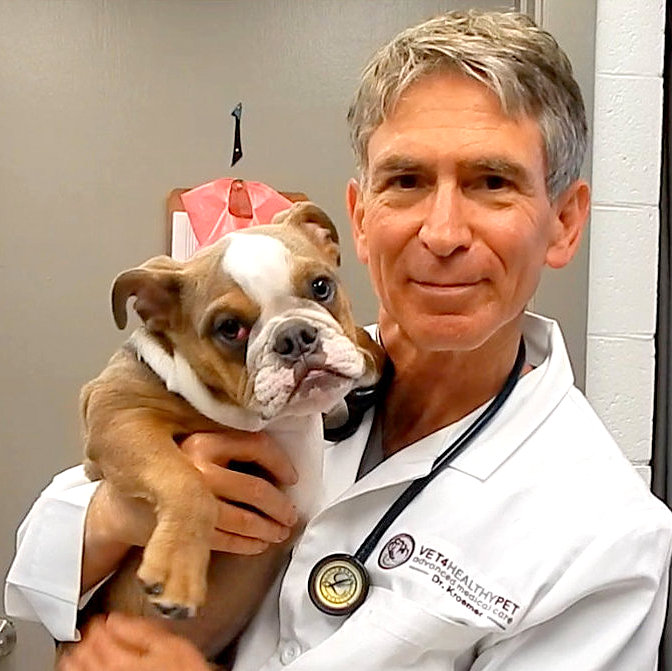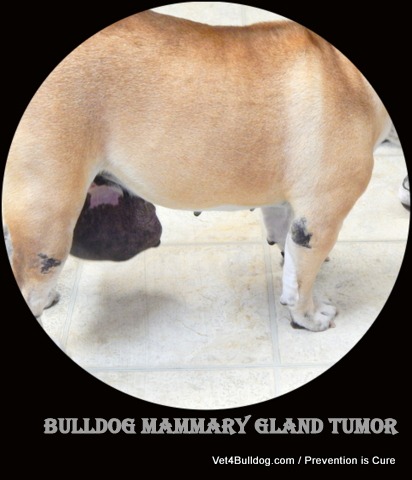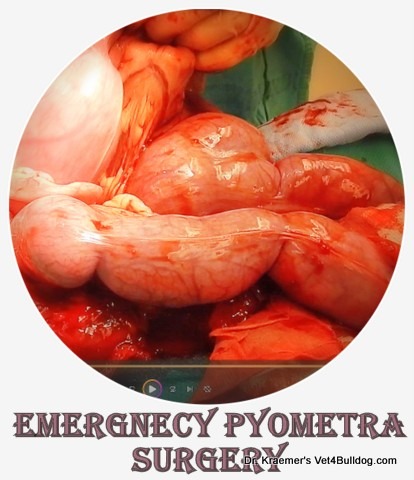Bulldog mammary gland tumors primarily originate from the breast tissue and are more frequently encountered in intact, older female Bulldogs. These tumors rank as the top tumor type diagnosed in intact female Bulldogs, while occurrences in males are infrequent.
Given the high prevalence of mammary gland tumors in intact female Bulldogs, proactive measures such as spaying are critical.
Early intervention can significantly improve outcomes and reduce the likelihood of malignant progression.
Breast Tumor In Bulldogs and French Bulldogs / TYPES:
There are two common types of bulldog breast tumors: the first is benign with an excellent prognosis, and the second is cancerous with an unfavorable prognosis
BULLDOG MAMMARY ADENOCARCINOMA:
Approximately 50% of mammary gland tumors in bulldogs are malignant, mostly classified as carcinomas; they are aggressive, usually larger, and often ulcerative, can spread to local lymphatics, and by the time of diagnosis, 50% have already metastasized to the lungs.

BULLDOG MAMMARY ADENOMA TUMOR
The remaining 50% are benign and mostly characterized as adenomas; they are often smaller in size.
It’s important to recognize that enlargement of the breast or findings of “growth” are not always tumors. Examples are
- Cystic
- Mastitis: often includes cloudy, milky discharge
Mammary Breast Tumor In Bulldogs / CAUSE:
The primary cause of mammary gland tumors in dogs, including bulldogs, is hormonal influence, with estrogen and progesterone playing significant roles.
Estrogen, often referred to as the “heat hormone,” is highly implicated as a major contributing factor to the development of these tumors. This hormone, associated with the estrous cycle, has a direct impact due to the presence of estrogen receptors in the breast tissue.
Progesterone, known as the “pregnancy hormone,” also contributes to the risk of developing mammary tumors. Like estrogen, progesterone affects mammary tissue through its receptors located in the breast, further establishing the hormonal link to these tumors.
OTHER
- Genetics
- Obesity & Diet
- Stress
- Carcinogens
Mammary Breast Tumor In Bulldogs DIAGNOSIS
Mammary gland tumors (MGT) in dogs can present in a variety of ways, ranging from a small, subtle mass that may be as tiny as a bird’s beak (referred to as “BiBi” size) and buried within the breast tissue, to a large, hard, and easily detectable growth. Given that dogs possess an extensive mammary chain with multiple breasts—far more than the two typically found in humans—it’s crucial to thoroughly examine the entire mammary chain for any abnormalities.
BREAST EXAM
This regular examination is particularly important for intact older female dogs or those that were spayed after experiencing their second heat cycle, as these dogs are at a higher risk of developing mammary gland tumors. Detecting these tumors early can significantly improve the management options and outcomes for the affected dog.
When checking your dog for MGT, it’s important to gently palpate each mammary gland, feeling for any lumps, bumps, or changes in texture. Any irregularities should prompt a visit to the veterinarian for a more comprehensive evaluation, which may include a biopsy to determine the nature of the growth.

OTHER DIAGNOSTIC TESTS FOR SUSPECTED BREAST TUMOR
- Blood, CBC chemistries, and urine analysis
- FNA: needle aspirate of the mass for cytological exam
- biopsy for histopathology of the mass and any suspected local lymph nodes
- Chest and abdominal radiographs for any suspected cancerous breast mass
- Abdominal ultrasound
Breast Mammary Tumor in Bulldogs: PREVENTION
SPAY: The most critical prevention is spaying your bulldog before her first heat, around 6-7 months of age, or no later than after her first heat. This measure will reduce the former by 99% and the latter by more than 90%.
Your bulldog chance of having a breast tumor is near zero if spayed before her first heat cycle
OTHERS:
- A quality-balanced diet
- Lean body weight
- Relaxed, stress-free home
- Avoiding carcinogens and toxins
BULLY THERAPEUTIC SUPPLEMENTS
- V4B Bully Immune Support: medicinal mushrooms
- V4B Bully HEMP Calm & Relax
- V4B Bully Probiotics: healthy bowl microbiome
- V4B Bully Multiviamins: Anti-oxidants
- V4B Bully Fish Oil EFA: anti-inflammatory

Mammary Gland Tumor (MGT) in Bulldogs / TREATMENT:
SURGICAL REMOVAL:
Surgical removal of mammary gland tumors is almost always recommended. The choice between a lumpectomy (removal of the lump and a small margin of surrounding tissue) and a mastectomy (removal of one or more mammary glands) depends on the size, location, and stage of the cancer, as well as whether it has spread.

LYMPH NODE REMOVAL AND BIOPSY:
Checking the lymph nodes for cancer spread is crucial. If the nearby lymph nodes are enlarged or suspected of containing cancer cells, they are often removed during the surgery for a biopsy. The presence of cancer cells in the lymph nodes can indicate a more aggressive disease and the potential for cancer to spread to other parts of the body.

ONCOLOGIST CONSULT:
Oncologist: If the biopsy results show that cancer has spread to the lymph nodes or if there are other factors suggesting a high risk of metastasis, consultation with a veterinary oncologist is recommended. They can provide advice on the best course of action, which may include chemotherapy or other systemic treatments.
BULLDOG BREAST TUMOR REMOVAL TIP
Before removing a suspected or known cancerous mammary tumor, chest radiographs should be taken to rule out visible metastatic disease. If found, mastectomy is not recommended due to the grave prognosis, pain, cost, and anesthetic risk.
Recommended by Owners Approved by Bulldogs


















